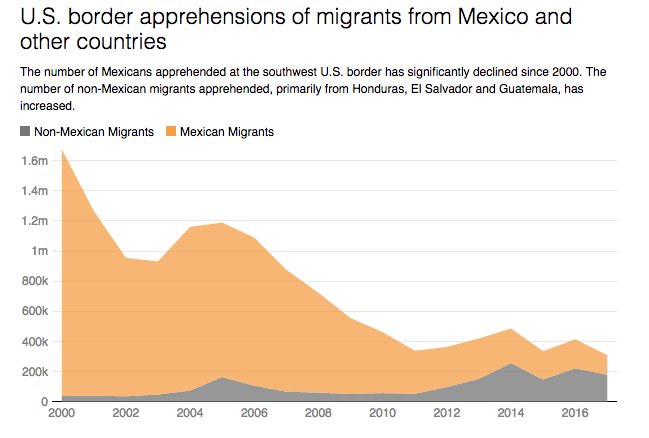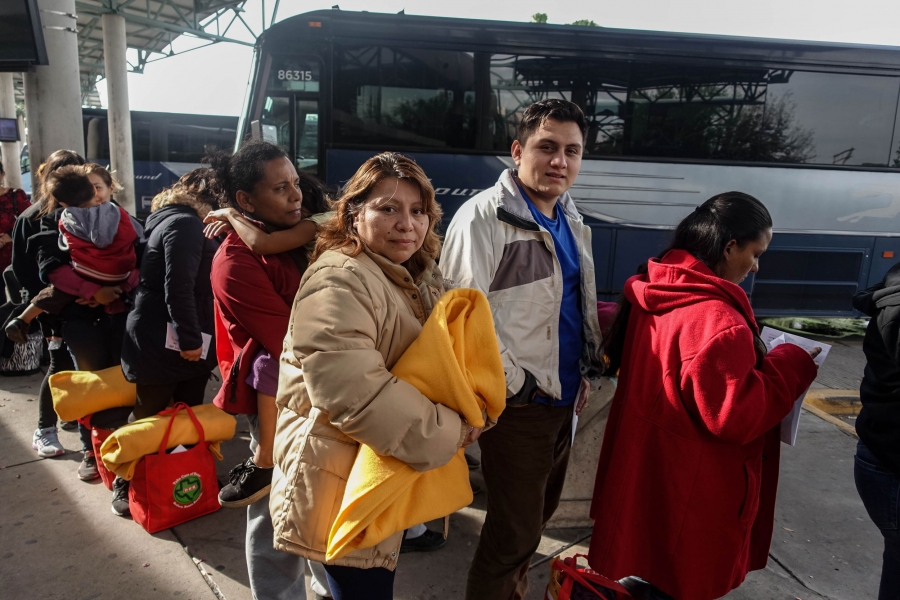The Donald is always and everywhere to be lauded for his enemies—-the bipartisan Washington political class that is bankrupting America with Empire First abroad and is asphyxiating the main street economy with monumental debts and Bubble Finance windfalls on Wall Street.
But when it comes to actual policy, it can no longer be gainsaid: The Donald is out of his ever lovin’ mind. For example, last weekend he threated to closedown the entire US/Mexico border—including $1.7 billion per day of two-way trade:
On Friday, Trump said “there’s a very good likelihood” he would close the southern border this week.
“Mexico is going to have to do something, otherwise I’m closing the border,” Trump said.
“It could mean all trade” with Mexico, Trump said….“We will close it for a long time.”
Well, it wouldn’t take a “long time”. That’s because the $615 billion worth of two-way trade between the US and Mexico last year represents not just a massive amount of goods, but also thousands of infinitely complex, hair-trigger supply chains that would unravel into economic chaos within days, cascading through the US economy like a lethal contagion.
Indeed, within 10 days at the current activity pace, there would be 160,000 northbound trucks piled-up at the Mexican border. That would make the allege horde of 66,000 illegals arrested during the entire month of February look like an orderly procession.
In fact, even though the pile-up of asylum seekers at the US/Mexican border is due to temporary factors and not remotely the law and order threat that the Donald demagogues endlessly about, the numbers involved are trivial compared to the daily volume of trucks, trains and trade.
For instance during 2018, the number of illegals apprehended at the Mexican border for all reasons averaged about 1,200 per day. But during the same period, truck crossing averaged 16,500 per day.
Even during the illegal immigration peak way back in the year 2000, the number of arrests per day (4,400) of people was barely one-fourth of the current northbound flow of trucks—to say nothing of virtually the same flow from US farms, factories and warehouses going south into Mexico.
For example, most of the 50 auto assembly plants in the US receive a huge flow of components and parts from Mexico on a JIT (just-in-time) basis nearly every day, meaning that within a week the entire US auto assembly industry would be shutdown, impacting more than 400,000 jobs.
And that would be just the start of it.
Last year the US imported $93.8 billion of autos and parts from Mexico. That’s a quarter billion dollars per day of product flowing both to US assembly and powertrain plants, but also finished vehicles to dealer lots. Accordingly, for certain brands like Ford and GM dealer lots would be empty within weeks.
At the same time, US factories exported nearly $90 billion of electrical and mechanical machinery, equipment, appliances, boilers etc to Mexico last year. That’s also a quarter billion dollars per day of southbound shipments that would cause an immediate explosion of inventories among US suppliers and a cascading sequence of plant shutdowns and layoffs.
At the same time, a huge share of fresh fruit and vegetable produce in US supermarket flows from Mexico, especially this time of year. In fact, during 2018 the US imported $14 billion of fruits and vegatables from Mexico, and these account for more than 46% of all US imports of these products.
Accordingly, shelves would be empty in days, as it would not take more than a few hours of news coverage of trucks backed up at the border as far as the eye could see to induce panicked US consumers to clean out the supermarket produce departments of every last tomato, avocado and kohlrabi, too.
The enormity and complexity of US/Mexico trade is so obvious that you really have to wonder what lies in the empty space under the Donald’s orange mop-top.
He actually dismissed the entire issue because he truly believes that trade is like a basketball game where the highest score takes all the glory; or a business income statement where the trade balance is akin to the profit and loss entry:
“I’ll just close the border, and with a deficit like we have with Mexico and have had for many years, closing the border will be a profit-making operation,”
No it won’t. It would be a calamity of monumental proportions; and it would also be an unforced error that the current debt-burden, financialized US economy absolutely could not withstand.
Needless to say, the Donald has gone off the deep-end on the Mexican border issue and the current back-up of mainly asylum seekers from the failed states of Guatemala and Honduras because the border invasion meme works with his 30-35% political base.
But it’s a Fake Crisis, if there ever one. Contrary to the Donald’s incessant bombast, there is no horde of dangerous entrants swarming the border; no outbreak of crime on the US side of the line; and absolutely no shred of a national security threat whatsoever.
As to the alleged hordes of menacing immigrants, you only need to glance at the chart below to see that is pure Fox News bunkum.
The 450,000 unauthorized immigrant apprehensions at the southwest US border in 2018, in fact, represented a 73% plunge from the level in the year 2000. And when it comes to Mexican migrants, the decline has been nearly 90%.
The fact is, as described below, the ballyhooed surge in border apprehensions in the last several months is entirely attributable to asylum seekers from central America who become part of the statistics when they voluntarily turn themselves in at the crossings.

Likewise, there is no evidence of crime spilling over the borders. To the contrary, on three leading measures of crimes per 100,000 population in 2017, the counties which border Mexico have lower rates than for the rest of the US.
For example, there are 3.4 homicides per 100,000 in the border counties compared to a 5.2 per 100,000 rate in the rest of the US.
In the case of the property crime rate, it is 2,207/100,000 in the border counties and 2,256/100,000 in the rest of the country. And when it comes to all violent crimes including assault, battery rape, muggings etc the rate is 348/100,000 in the border counties and 379/100,000 in the rest of the nation.
Indeed, on the crime flowing over the border file, the Donald pulled a downright fast one in his speech. He cited ICE arrest statistics, which suggested that 66% of these cases involved illegals who had previously been convicted of a crime—-and in many cases violent ones.
But here’s the thing. The Immigration and Customs Enforcement agency (ICE) doesn’t patrol the borders!
For better or ill, it is in the deportation business, and as a matter of operating procedure targets likely criminals for its raids and arrests throughout the interior of the USA. That is, there is an inherent high criminal ratio in the ICE arrest statistics because that exactly what its mission entails.
By contrast, it is the Border Patrol which picks up illegals along the border. For the year 2018 through August 31, it apprehended 361,993 undocumented immigrants, but only 6,259—or 1.7%—had a prior criminal record according to Border Patrol data.
Moreover, 3,600 or 58% of these criminals were actually circular criminals. That is, they had previously been convicted of illegal entry into the U.S. (a misdemeanor) or reentry (a felony). Another 1,000 had been convicted of driving under the influence of alcohol.
In fact, among last years 361,993 apprehended illegal border crossers, there were only three convictions for manslaughter, which implies a rate per 100,000 that is 75% lower than for the general US population; and a total of 506 convictions for assault, battery or domestic violence, which also implies a rate far below the US average.
Yes, there is a serious crime problem associated with the Mexican border, but it is one manufactured in the legislative chambers of Washington, not along a fenceless border.
We are referring, of course, to the War on Drugs, which makes prohibited substances immensely and artificially valuable, thereby fueling a massive, violent underground distribution system that is the number one source of violent crime in America.
To be sure, many if not most illegal drugs can be harmful to personal health or even fatal—-just like cigarettes, too much alcohol or Kentucky Fried chicken or sky-diving. But the distributors of Marlboros and Jim Beam don’t kill people who distribute their product or inflict violent mayhem on neighborhoods in order to enforce business deals, such as cartel territorial rights.
At the end of the day, handling, processing and care for asylum seekers may well be a fiscal problem of small beans dimension in the scheme of a $4.6 trillion budget, but its not a crime or national security problem that would even remotely warrant resort to the absolutely insane idea of closing the border.
In fact, here are three vignettes that should have far off his rocker the Donald has gotten in his quest to feed red meat to the base.
Most notably, the increase has accelerated in the months since last June, when Trump announced the end of the United States’ “zero tolerance” policy where children were separated from their parents at the border.
Rubén Gómez and his son Steven, 11, from Nicaragua
Gómez: “The trip to the border was 14 days. It was a very sad trip. Because I left my family behind — my wife and my 14-year-old daughter. It’s the first time I left Nicaragua. I come from a small town. I was a farmer. One day a cousin who lives here in the US called me and said, “Do you want to come?” I didn’t want to because of my family, but he said the law in the US now allows people to come with their kids. And the [political] situation in Nicaragua is getting really bad. Last year there were protests, and people left dead in the streets. My cousin lent me $6,000 to pay the smuggler. I came with my 11-year-old son. He didn’t go to school in Nicaragua because it was too far away. In the US there are more opportunities. The idea is to work hard and bring the rest of the family.”

Patricia* and her son, Jim, 17 Patricia:
“We are from a “red zone” in Guatemala City. I came to the United States with my son because the gang Barrio 18 was extorting us for $10,000. The first time they called me, in October, I thought it was a joke. But in late January, they told me that if I didn’t pay they were going to kill my son, and that they knew where I lived, where my business was. I had a beauty salon there. The gang told me if I went to the police, they would find out because they had informants there. They said I had one last chance to pay or that someone would find me or my son’s dismembered body. My son and I fled Guatemala then and there. My brother, who is in the US, lent me $6,000 to make the trip. I left behind two daughters, 10 and 8, with my mom.”

Ana Patricia Castellano, 34, from Comayagua, Honduras, with her 4-year-old daughter, Alejandra Sofia.
They are headed to Florida, where Castellano has an uncle. Castellano: “It’s practically impossible for women over 30 to work in Honduras. When we look for jobs, we are told we are too old. I came to the United States to help my kids get ahead. I heard on the news they were letting people come in with their kids. Not 100 percent, but 99 percent. I left two daughters in Honduras — one is 16 and the other is five. I would have liked to bring them, but I can’t — not yet at least.”

